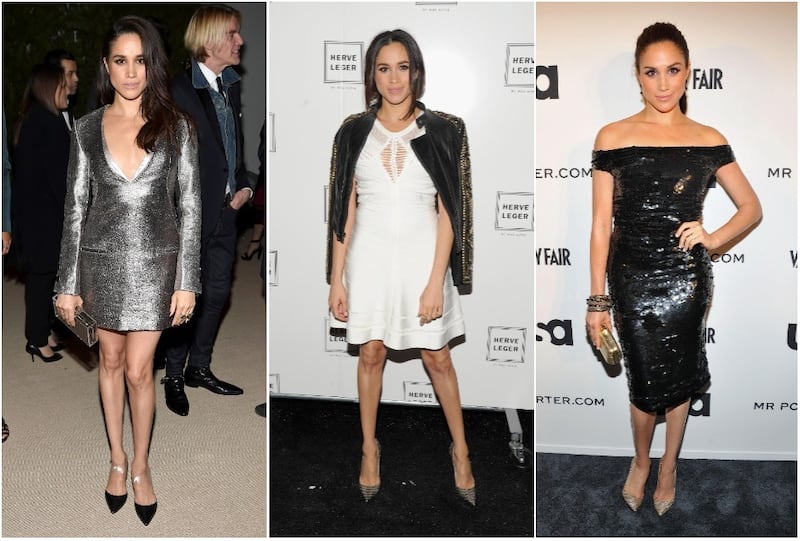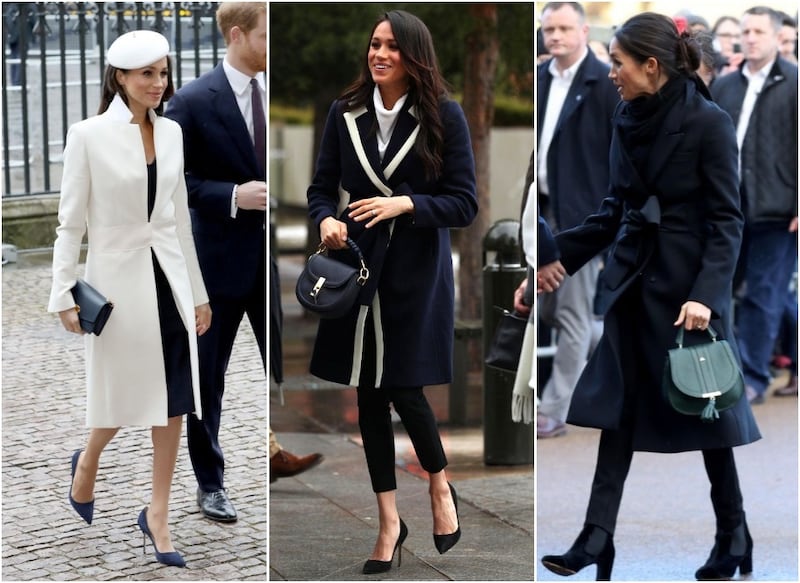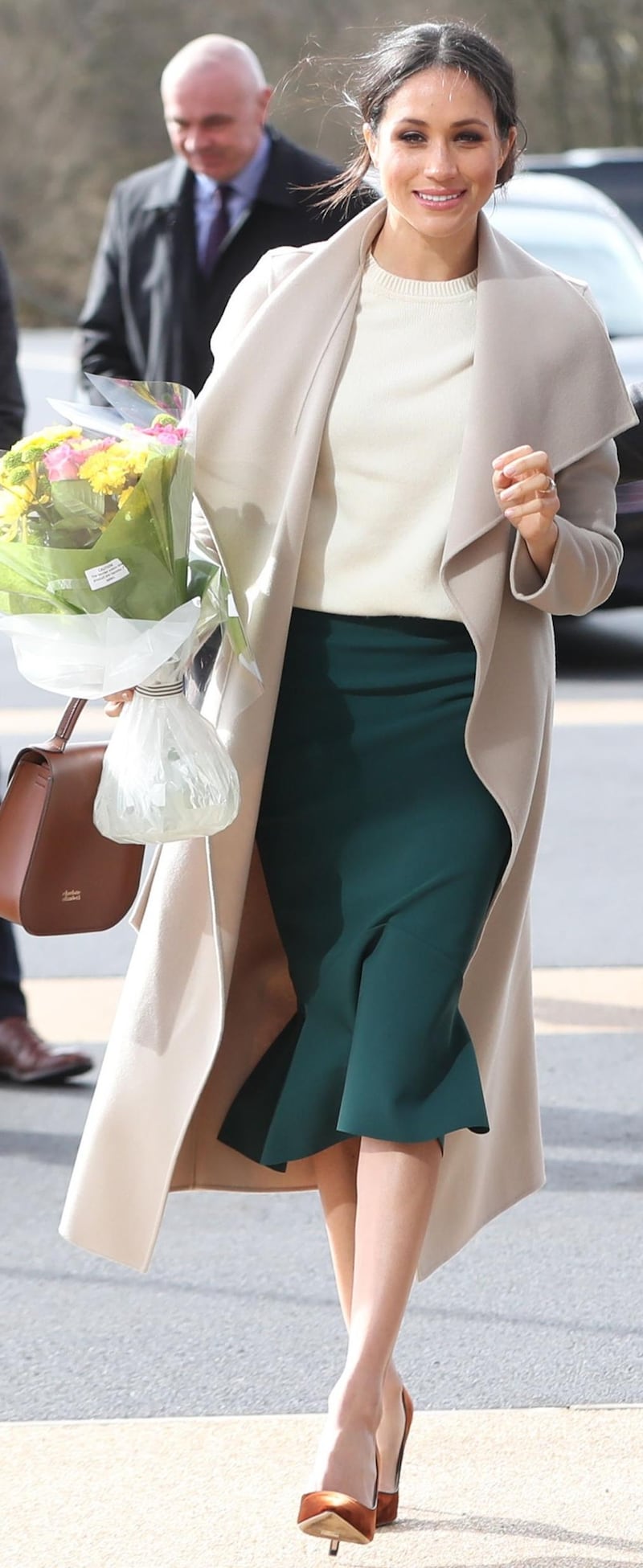What a difference a couple of years makes. Coming to the role of royal with a record, Meghan Markle was a Hollywood actress and lifestyle blogger. Shooting to fame with her role as Rachel Zane in legal drama series Suits, Markle also dabbled in other projects particularly as the editor of The Tig, a lifestyle website where she published recipes and travel guides and humanitarian interests including working with World Vision, One Young World and the United Nations. A red-carpet professional with years on the Hollywood circuit, Markle honed her style credentials with appearances at New York Fashion Week.
With a penchant for pencil skirts and sheath dresses akin to her Suits character, Markle was known for her glamorous look with a love of designers such as Roland Mouret and Dolce & Gabbana.
The abbreviated hemlines and second-skin silhouettes she once chose have now become a thing of the past as she furiously forges her way to a wardrobe worthy of a duchess.

She has emerged as a fashion (and soon to be royal) thoroughbred, with a new appreciation and preference for clean lines, and an elegant lack of fuss. Markle’s burgeoning style has materialised as simple, streamlined and neutral, choosing a palette of monochrome and tonal looks in recent months.
With an emerging signature style much imitated and emulated and an entire network of Markle social media fashion-watchers, such as @whatmeghanwore, @madaboutmeghan, and @meghanmdaily, keenly surveying every style move, the Markle Sparkle is certainly shining bright. Her sartorial choices discreetly reveal what kind of royal she proposes to be and it is an interesting lesson in politically dressing. Nothing is thrown on by chance – this is considered styling and with a strategy firmly in place.
Whether it’s wearing a Time’s Up pin on the Oscars’ red carpet or sending cryptic codes about a relationship status via jewellery, celebrities and public figures often use the language of clothing and accessories to communicate critical messages. Remember when Princess Diana, who ruled the art of royal dressing. wore a black off-the-shoulder dress by Christina Stambolian that was famously coined the revenge dress? Take Markle’s future sister-in-law Kate Middleton, who’s big on diplomacy dressing, if you will; she’s fond of wearing outfits by designers from the country she is visiting.
Markle has been clearly taking notes. She has been using her wardrobe to send subtle messages in a perfect blend of glamour and diplomacy about sustainability and provenance. Supercharging under-the-radar labels and delivering a PR boost to brands with charitable efforts, she oozes lessons in sartorial statecraft.

On a recent trip to Cardiff in January she chose a wrap coat designed by eco-conscious British designer Stella McCartney, paired with jeans by Huit Denim, a small sustainable Welsh brand set up to bring denim manufacturing back to Wales. Huit Denim limits production to 100 pairs a week while offering free repairs for life.
Making another fashion statement with extra impact, Markle elegantly swung a green bag by little-known label DeMellier London, a British brand with a charitable initiative, donating a set of lifesaving vaccines for children in need in the name of every customer that purchases one of their bags. A clever move by the royal-in-waiting, proving your “it” bag can mean more than a fashion statement.

She reinforced this message on Friday on a visit to Northern Ireland when she stepped out, in a tribute to Ireland, in a green skirt by Canadian designer Greta Constantine and recycled knit by Victoria Beckham. Markle also accessorised with a brown leather handbag by Charlotte Elizabeth – a designer supported by the Prince’s Trust, an organisation founded by Princes Charles which helps young people get jobs, education and career training.
As well as demonstrating her love of altruism, Markle could be hinting at her feminist beliefs through her style choices. For the Commonwealth Day service – her first official engagement with Queen Elizabeth – she chose a hat by milliner Stephen Jones. In an interesting twist, Jones has designed the protest berets at Dior’s collections for the past three seasons, as commissioned by Dior designer Maria Grazia Chiuri, who is known for incorporating political messages about women’s rights into her collections. Others speculated it was a tribute to Princess Diana, who Jones produced a variety of berets for during her 20s.
In contrast to the Duchess of Cambridge, who prefers to stick to well-known fashion names, such as Reiss, LK Bennett, and Alexander McQueen, Markle has road-tested a slew of brands few have heard of, even by the well-versed in the fashion industry. For her first royal engagement in Nottingham, Markle chose a navy and burgundy tote by Scottish brand Strathberry, which quickly sold out after the first photos surfaced. Other lesser known brands Markle has endorsed are Mackage, Pharosh, Misha Nonoo, and Finlay & Co.
With her role in the royal family not as formal as Kate Middleton’s, she is able to rewrite royal dress codes. Granted, it’s not exactly groundbreaking – she balances sleek and directional without looking too overtly “fashion”. Her signature looks – perfectly imperfect, with unstructured hair, minimal make-up and accessible basics – are refreshing and signal her out as a very modern royal and commercial gold.










